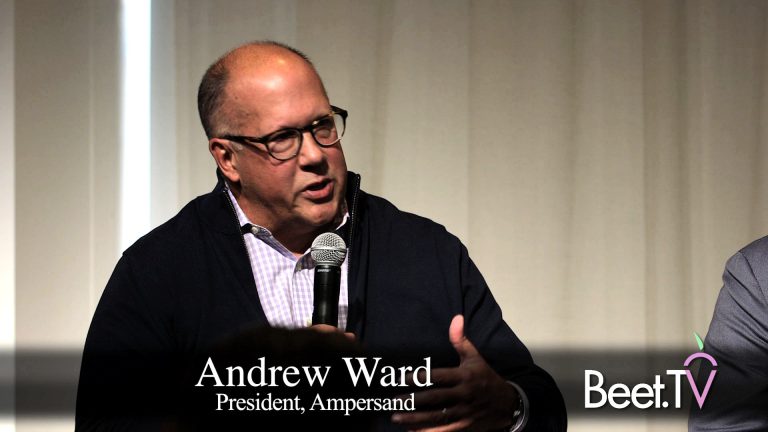
The new super-power coming online in TV is tracking not only individuals’ viewership of shows and ads but, also, linking that viewership with eventual viewer outcomes, like website visitation, store visitation or even ecommerce purchase.
That is why we are seeing so much discussion on whether advertisers will change their use of TV, which, traditionally – in absence of such metrics – has been to use a mass audience for brand building, toward using it for “performance” outcomes.
But how far will the pendulum really swing in this direction? At Beet Retreat In The City, a panel, “TV In Transformation as Addressable Lights Up”, heard executives discuss that question…
- Ampersand – Andrew Ward, president
- Viacom – Julian Zilberbrand, EVP of audience science
- Charter Communications – Rob Klippel, SVP of advanced advertising products and strategy
Their discussion was led by Janus Strategy & Insights president Howard Shimmel.
Data to feed the top
Ampersand is the former NCC Media, a group owned by Comcast, Charter Communications and Cox Communications to ease the path to ad sales on cable and now new-wave TV platforms.
Ampersand’s Ward said:”How can we use deterministic data in defining audiences more narrowly and more robustly just to look at traditional media measures – reach, frequency on duplicated reach, not in isolation, but in addition to attribution work and brand outcome measurement?
“I think a lot of attention is paid to bottom-of-the-funnel performance measurement. I think a tremendous amount of progress can be made in the industry as we begin to think about deterministic data driving traditional media measures.”
Best of both
That amounts to: “Don’t throw the baby out with the bath water.” In other words, TV will be able to support performance-driven ad attribution at the bottom of the funnel as well as top-of-funnel brand-building.
Charter’s Klippel said: “When you look at what TV does well, (it) scale, it’s reach, it’s high-quality produced video and brand-safe environments.
“Also, the engagement of TV and the emotional engagement (beats digital). I’ve never heard anyone run around quoting taglines or saying dillydally after watching it in a digital campaign.
“We’re still getting our arms around that to kind of bring the best of the two together. When you look at what’s happening with viewership trends, there’s no doubt that there is a shift, but there’s also absolutely no doubt that there’s still a lot of eyeballs on ad-supported TV.”
Determining ‘deterministic’ TV
The event was notable for industry executives discussing a new buzzphrase – “deterministic” TV advertising. Other panelists have already attempted to define that.
Ampersand’s Ward offered his definition: “Data that is held to be true versus probabilistic data, which I think is oftentimes inferred or based on panel survey modelled data.
“Probably 10% of our business, thereabouts, is transacted on a deterministic audience-based data and the vast majority still on an age (and) gender panel survey-based.
“We don’t think that deterministic data replaces, overnight, survey-based probabilistic data. We think they will both live in harmony and serve different purposes in concert with one another.”
Joining data unlocks value
It isn’t just a single set of known data that creates the biggest opportunity, Ampersand’s Ward said. The real power lays in combining such data sets from different parties.
“It begins … with the name and address of the subscriber,” Ward said. “We know that to be true because the cable companies are sending a bill. Then you start to pivot off of that with other known sets of data – set-top box, ad exposure, commercial viewership, programme viewership data.
“The value that is available in the marketplace is the ability to unlock that data in concert with other deterministic data sets in the marketplace. (For example), Geico happen(s) to know the name and address of their policy holders and whether they’re a homeowner or a renter, if they own a motorcycle or an RV or a boat.
“So it’s that Venn diagram of being able to link deterministic data that we think begins to unlock value opportunity in the marketplace.”
Forecasting gaps
Viacom’s Zilberbrand said infrastructure issues pose a problem to any large-scale shift in the use of TV from brand-building to performance. Namely, forecasting data is too fragmented amongst the variety of operators.
“There are technology gaps with a lot of traditional TV companies that make it very, very complex to forecast,” he said.
“It’s variable depending on, ultimately, the operator that you’re working with.
“There are obviously, I know, efforts to kind of shift that and work towards that and provide solutions there.”
Beet Retreat In The City @ Horizon Media is presented by 605 and Spectrum Reach. For more videos from the event, please visit this page.